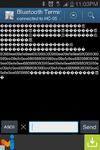Luis Daniel Bolaños
Member level 2

Hello there!
I have googled for a couple hours but I'm still confused about how to transmit from a PIC16F887 to a PC using the Bluetooth module HC-05 through UART communication. So I'm requesting your help! Oh, and I'm programming on C (still don't get the difference between MikroC and MPLAB X)
I need to transmit some basic characters from the PIC to the PC. So, do I just need to configure the UART as a RS232 transmission and plug in the HC-05? I read something about an AT mode of configuration but it is confusing me. I don't get how to pair the modules, how to configure... I'm lost.
Thanks for your help and sorry if I'm not more specific but don't know more details :-(
I have googled for a couple hours but I'm still confused about how to transmit from a PIC16F887 to a PC using the Bluetooth module HC-05 through UART communication. So I'm requesting your help! Oh, and I'm programming on C (still don't get the difference between MikroC and MPLAB X)
I need to transmit some basic characters from the PIC to the PC. So, do I just need to configure the UART as a RS232 transmission and plug in the HC-05? I read something about an AT mode of configuration but it is confusing me. I don't get how to pair the modules, how to configure... I'm lost.
Thanks for your help and sorry if I'm not more specific but don't know more details :-(




